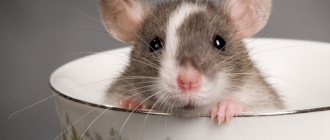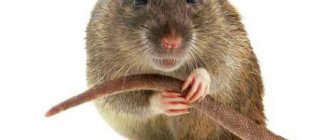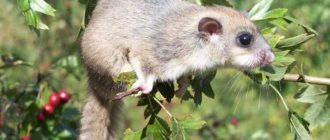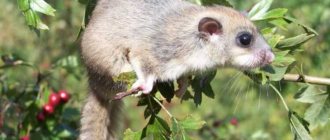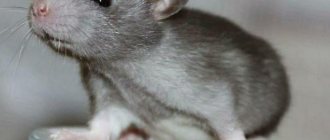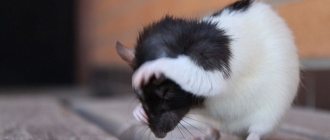Nobody knows when people first became acquainted with rats; this animal always lives next to us.
The rat belongs to the mammals, to the order - rodents, suborder - mouse-like. The most common animal on the planet is the rat.
Appearance of the rat, description and characteristics
The body of the rat is oval-shaped and stocky. The body of the animal is from 8 cm to 30 cm, weighing up to 500 g, there are small ones weighing 37 grams.
The eyes and ears are small, the muzzle is sharp and elongated. Is the tail longer than the size of the rat's body, hairless or covered with fine hair? invisible to the human eye (a type of black rat has a tail with a thick coat of fur). There is a species of short-tailed rodents in the world.A rat's teeth are arranged tightly together in rows and are designed for chewing food. These animals are omnivores; they differ from other predators in the absence of fangs and diastema - this is an area on the gums where there are no teeth.
There are no dental roots, so growth occurs continuously throughout the rat's life. For convenience, they need to constantly grind down their teeth, otherwise she will not be able to close her mouth.
The teeth are strong with hard yellow enamel, which makes it possible to easily chew through concrete, cement and hard various metals.
The rodent's body is covered with a thick, dense coat of guard hairs. The color range is varied, gray with different shades of dark or light, red, orange and even yellow.These amazing animals have movable toes on their paws, so they easily climb trees and prepare nests in hollows for habitat.
Rats are very active and agile animals, running 17 km a day and jumping up to 1 meter in height. They swim well, are not afraid of water and can catch fish.
Rats often turn their heads in different directions because they have a small viewing angle and see the world around them in gray tones.
Hearing functions perfectly, rats distinguish sounds with a frequency of up to 40 kHz (humans up to 20 kHz).
Life expectancy is from 1 year to 3 years. In laboratory conditions, rats can live 2 times longer.
When can you give?
The minimum age at which a small rat can be transferred to other owners is 5-6 weeks. At this age, he is already completely independent, has all the necessary life skills. Until this time, the animal must stay with its mother as part of the brood, since under these conditions it will have to learn everything it will need in adult life, for example, to arrange a home and build a nest.
There is also no point in delaying the transfer of the animal to another owner. Firstly, even if you are not going to give away the babies, at the age of 5-6 weeks you will need, at a minimum, to seat the females and males in different houses, since they will already be ready for mating. Secondly, the younger the animal, the easier it gets used to its new owners. Relocation to a new home occurs with virtually no fear or stress for the animal.
Did you know? During a stressful situation, a baby rat is capable of producing a sound equal in volume to a working jackhammer, but due to the ultra-high frequency, a person cannot hear it.
Difference between rats and mice
Rats and mice are representatives of the same suborder, but they differ significantly in appearance and behavior.
The body of a mouse is small, up to 20 cm, weighing up to 50 grams, rats are twice as large, they are dense and muscular, weighing up to 900 grams.
Pronounced distinctive shapes of the head and eyes, in mice it is triangular and slightly flattened with large eyes, in rats the muzzle is elongated with small eyes.
A strong body and powerful toes allow rats to jump high up to 1 meter; mice cannot do such tricks.
- Detailed description with photos of all animals included in the Red Book of Russia
Zebra - habitats, appearance, diet and behavior, life cycle + 94 photos
Leopard - habitats, life cycle, rutting season and lifespan + 118 photos
Mice are cowardly animals and are afraid to appear in front of people, but this does not bother rats; they can defend themselves. There are many cases where they attacked a person.
Rats are omnivores, eating meat and plant foods. On the contrary, mice have a greater preference for cereals and seeds.
How to feed baby rats
During the first 14-16 days, rat cubs feed only on mother's milk. Then they begin to become more active, crawling around the nest and even trying the food that their mother brings. 3 weeks after birth, the pups eat vegetables, grain mixtures, lean meat, eggs, cottage cheese, and fresh herbs.
There are often situations when small rats are left without maternal care. This happens for various reasons:
- Mom doesn't have enough milk;
- the female died after giving birth;
- someone touched the little rat with their hands, and the mother abandoned him.
In each case, the babies will have to be artificially fed, otherwise they will die.
Orphaned cubs must be kept warm. A lot of paper napkins are placed in the nest. They are replaced as they become dirty. To warm little rats, you can use a rubber heating pad or a plastic bottle with warm water.
To feed the litter, a cat or dog milk substitute, which is sold at a veterinary pharmacy, is suitable. If you can't find it, you can use baby formula. To increase the nutritional value, add a little condensed milk with a fat content of about 12% or glucose, as well as a little calcium gluconate.
It is convenient to feed small rats from an insulin syringe without a needle. The animal is carefully taken vertically in the left hand, and the head is held with the thumb and forefinger. The tip of the syringe is inserted into the mouth. The piston is moved very slowly so that the little rat does not choke.
Attention! If milk flows from the spout during feeding, it must be removed with a napkin. To clear the nasal passages of liquid, you should pinch the little rat's butt. When it beeps, the milk will completely leave the respiratory tract.
In the first week of life, rat pups are fed every 1.5 hours, then every 2.5-3 hours. At this age, they eat no more than 0.3 ml of formula at a time. It is quite simple to determine that the baby is full - his stomach is clearly visible through the thin skin on his stomach. It looks like a white transverse stripe. If its length is two-thirds the width of the body, then the stomach is full. Week-old rat pups eat about 0.5 ml of milk at a time, and at the age of 10-12 days - 1 ml.
Attention! Before each feeding, the baby rats receive a abdominal massage. This is necessary to improve intestinal motility. Gently move the fingertip clockwise for about a minute. Usually, after such stroking, the animals empty their bowels.
Why are rats dangerous?
Rats are a disaster for all humanity. They gnaw through walls in the basements of houses, sewer pipes, damage electrical mains, and damage crops.
Rats are carriers of more than 20 infectious diseases, such as leptospirosis, plague, salmonellosis, pseudotuberculosis and others. Many are dangerously fatal to human life.
It is difficult to exterminate rats using chemicals because the animal’s body quickly adapts to the poison and develops protective immunity to toxins.
Home for rodents
The habitats of these two representatives of the animal world are very diverse. Rats are not at all afraid of very hot climates or severe frosts. The homeland of these animals is Eastern China. Thanks to the development of shipping, they settled throughout the planet. These animals are very active at night, but if necessary, they explore new spaces during the day. Most often they live in burrows, which are very similar to labyrinths. There they make their nest, where they hatch and feed their offspring. All holes are made in such a way that they lead to the very center of this nest, which they carefully line with grass, wool and dry leaves. These dwellings are available for winter and summer.
Mice also live in burrows. Throughout the year they replenish their reserves for the winter. These animals are very shy and most often they are nocturnal. Their burrow is also a kind of labyrinth where a whole family lives, but one animal can also live. Despite their small size, in case of danger they will be able to boldly and bravely defend their shelter.
The teeth of these rodents are also different. Rats have only two types: 12 molars, 3 on different sides of the jaw, and 4 incisors.
The molars are very wide and flat, they are located far away in order to grind food well by chewing it. And their incisors grow throughout their lives; they use them to chew through very hard objects. Their teeth are yellow in color and have strong enamel. They have a very interesting feature - they can be moved apart when chewing food.
What do different types of rats look like?
These rodents avoid water whenever possible. But pasyuks are good swimmers and can stay in the water for up to several hours; sometimes, to get food, they dive deep, hunting for various mollusks and even frogs, and are not afraid to be under water for a long time.
Rats are a pet
Rats are ideal pets. They quickly become tamed to humans and recognize their owner by the face.
Neat and clean animals do not require special care. They will give their owner many funny moments; they are very interesting to watch.
But the owner of a pet rat should not forget that this is a social animal and it is difficult for him to live alone. The rat definitely needs a mate, otherwise a mental disorder may develop.
How long after birth can you pick up
Seeing small newborn lumps swarming around an adult female, you just want to pick them up or at least touch them. Under no circumstances should this be done. Firstly, their body is still very fragile and the slightest wrong movement or compression can lead to injury to the baby. Secondly, after you hold the baby in your hand, its coat will acquire a specific human smell. Mother rats often abandon such babies: they stop taking care of them, don’t feed them, and don’t keep them warm. The result is inevitable death. Despite all the caring behavior of females towards their offspring, they can kill a baby that emits an alien odor.
You will be interested to know what to do if decorative rats fight among themselves.
By three weeks, babies already look strong enough and can eat “adult” food. Even if the female does not want to accept a cub that smells like a human, it will be able to live and feed on its own. Experienced rat breeders recommend not delaying the taming of decorative rats. When the animal is a month old, it needs to be taken as often as possible, then the baby will be more obedient and affectionate.
Type of rat, name and photo
There are about 70 species of rats in the world, most of which are little studied; below are common types of rodents with a brief description and photo of the rat.
The gray rat (pasyuk) is one of the larger species, up to 25 cm long, the tail is not taken into account. Weight from 140 grams to 390 grams, with a wide, elongated muzzle. The gray coat of young animals becomes orange with age. It lives near water, in dense vegetation and digs holes up to 5 meters.
The black rat is smaller in size than the gray rat, with a much smaller muzzle and rounded ears. Body length up to 22 cm, weight about 300 grams. A significant difference between this species of rodent is the tail, which is densely covered with hair and 4-5 times longer than the size of the body.
Lives in Asia, Africa and Europe. It can live for a long time without water, so it lives in dry places. The wool is black with a green tint.
The small rat differs from its fellows in size. Body length up to 15 cm maximum with body weight up to 80 grams. It has a brown coat color, a sharp muzzle and inconspicuous small ears. The tail is as long as the body without any signs of fur. Lives in Southeast Asia.
The long-haired rat is characterized by long hair and high activity. Males grow up to 18 cm, and females up to 16 cm in length. The tail is 4-5 cm smaller in size from the body. Habitat in arid deserts.
The Turkestan rat lives in China, Nepal, Afghanistan, and Uzbekistan. The fur is red, the belly is pale yellow, the body length is up to 23 cm. This variety is similar to the gray one, but has a denser body and a wide head in size.
Black-tailed rat or rabbit. It has average dimensions up to 22 cm, weight about 190 grams.
An interesting feature of this type of tail is a tuft of hair at the tip.
The back is gray and brown with visible black hairs.
They live in Australia and New Guinea mainly in eucalyptus forests, dense grass and shrubs. They lead an active lifestyle at night and hide in burrows during the day.What do newborn rat pups look like?
The decorative rat bears its cubs for 20-26 days, the period depends on the size of the litter. There are from 2 to 9 babies in one litter.
Newborn rat pups look completely helpless. They are born naked, blind and deaf, with underdeveloped limbs and a very short tail.
Rats can only move their paws and open their mouths. Despite their helplessness, babies are able to find the only available source of nutrition, the mother's nipple, by smell.
At birth, a small rat weighs 4-6 g. If the litter is large, then it contains cubs weighing 3 g. The body length of a newly born rodent depends on the sex and is 5-9 cm. Boys are usually larger than girls.
Newborn rodents have pink, thin skin. Blood vessels and internal organs are visible through it.
Interesting and educational facts about the life of rats
In India there is a Karni Mata temple where rats are revered, cared for and protected. If the rules for caring for a sacred animal and killing it are violated, this person is obliged to bring a golden figurine in the form of a rat to the temple.
In some American states, it is illegal to hit a rat with a baseball bat and can result in a $1,000 fine.
In Asian and African countries, rats are considered a worthy delicacy for a festive dinner. Rat meat is considered a delicacy.
A gray rat eats up to 12 kg of various cereal products per year. Experts have calculated that every year about 6 kg of one farmer’s harvest is spent on feeding one rat.
Younger age
Starting from the fourth day, the development of little rat pups occurs at a rapid pace.
- 4th day the ears open, the pups begin to distinguish sounds and hear rustling sounds;
- 6th body is covered with soft dark fluff;
- On the 8th, teeth emerge, except for the main incisors.
After 10 days of life, the pups become active. They crawl well and master the terrain. If these are pets, they should be handled more often so that the animals grow up tame. However, during the game they should not be left unattended, since coordination of movements is not yet developed, the kids can fall to the floor from a table, any height.
Photo of a rat
Coat color
There is a wide variety of colors and coat tones for decorative types of rats. Based on this criterion, they are divided into groups.
Homogeneous
With uniform coat color in decorative rats, all hairs should look the same and be the same color.
The following colors are available:
- black;
- white (albinos);
- Russian blue and smoky blue, which differ only in the intensity of the tone;
- brown-gray;
- platinum;
- beige;
- champagne
There are several types of light gray color:
- with a blue tint (Russian silver);
- with a pink tint (dav);
- with a chestnut tint (lilac);
The name of the color is also determined by the color of the eyes. For example, rats with champagne coat colors should have pink eyes. And in white decorative rodents they are red and black.
Ticked
Each fur of such a rat is colored in several colors:
- Agouti. The basis of the classic color is soft brown hairs with black tips. A silver-gray tone predominates on the belly. Blue agouti is characterized by a combination of brown with silver or cool blue color. The platinum agouti has light gray and beige hairs that are effectively complemented by a blue tint.
- Amber. An ivory band is visible on the orange and fiery yellow hairs. The undercoat is a delicate cream color, the eyes are pink.
- Cinnamon. On the back, red-brown hairs with a bright golden edging predominate, and on the belly, gray and silver hairs predominate.
- Faun. The predominance of coffee-golden color, the silvery tint to which is given by guard hairs. The fur in the belly area is silver-cream in color. Fauns have dark ruby eyes.
- Topaz. Light coffee hairs are combined with silver ones. In color, these rats resemble fauns, but have a lighter shade of undercoat, due to which the entire color of the coat appears less saturated. Most often, they can only be distinguished by specialists who know what color these two types of rats are.
- Pearl. The color contains beige, golden and gray shades. The belly is sandy, with a grayish tint.
Silver
A peculiarity of this type of rat is the combination of hairs colored silver and other colors in equal proportions. The fur of such rodents must shine and sparkle.
A silver tint can set off a black, blue or brown tone.
Combined
This type includes rats whose color contains 2 or more shades:
- Siamese. The rodent's fur is beige in color, which becomes more saturated in the back of the body. The tail is uniformly dark. Brown spots are located on the face, ears and the bottom of the paws.
- Himalayan. The uniform snow-white coat has dark brown spots. A special feature is the red eyes. Black-eyed Himalayan rats have cream-colored spots.
- Burmese. The main coat color on the body can vary from sandy to brown, with darker spots on it. The tummy of rodents is distinguished by a gray-white color.
- Sable. The coffee color is combined with dark brown spots on the limbs.
Rats that combine white and colored parts of their fur in a certain order are called marked. The marking may take the form of a cloak, hood or train.
Body type
Depending on the shape of the body, the length of the tail and the shape of the ears, all decorative rats are usually divided into three main varieties.
Standard
This type of animal has a proportional body covered with hair, including paws, tail and ears. The tail, wide at the base and tapering towards the end, is approximately equal to the length of the body. The ears are round in shape and located at the top of the head. The eyes are round, protruding and shiny. The long mustache is evenly distributed across the cheeks.
At exhibitions, they don’t take into account what color the rats’ fur is. The main criterion for its evaluation is the qualitative characteristics that indicate the health of the rodent. These include:
- shine;
- tight fit;
- uniform distribution over the entire surface of the body.
Animals that have genetic mutations are removed from breeding.
Dumbo
Dumbo rats get their name from the distinctive shape of their ears, which are reminiscent of the flying baby elephant from the Disney cartoon of the same name. Wide and round ears are located on the sides of the head, due to which it looks slightly widened and flattened.
In some individuals, the back of the head may protrude slightly, but this should not be noticeable.
The back part of the body of this species of rodent is expanded, which gives the body a pear-shaped shape.
Dumbos come in a variety of colors, but black and white rats are the most common. In this case, the design looks like a hood.
Tailless (Manx)
The Manx rat has a more rounded and shorter body shape, unlike representatives of other varieties. The hind legs are longer than the front legs, the tail is completely absent. Thanks to this, the rat looks unusual and resembles a rabbit.
Many people choose tailless pets for aesthetic reasons. But you should know that most of these rodents develop pathologies of the hind limbs and organs of the genitourinary system.
When buying a Manx rat, you need to make sure that the absence of a tail does not cause discomfort to the rodent when moving.
Prevention
When a rat has no problems and is not sick, its eyes, nose and mucous membranes are absolutely clean. When there is porphyrin in your pet's nose (for no reason), your pet requires the attention of a specialist. At the veterinary clinic, they will take tests and examine the animal, as a result of which it will be possible to understand whether everything is normal or whether there is a disease. In the latter case, the doctor will prescribe treatment at home or prescribe procedures at a veterinary institution.
To prevent the animal from developing bad symptoms, the owner must follow the following rules:
- the cage with the pet should be located in a quiet, calm place - the animal needs comfort;
- The animal should not be stressed, make noise, shout or wake it up abruptly - this will scare it;
- the rat must be fed healthy and wholesome food;
- You constantly need to monitor your pet, its condition, skin and mucous membranes.
Relationships with people
Albinos are quite smart and cunning animals, but they are quite trainable.
White rats almost always remember their nicknames, and they can also remember the nicknames of their other relatives who live in the neighborhood. Remember! You should buy a cage with a more secure lock, as these rodents can learn to open cages with simple latches.
A simple latch on the door is not an obstacle for an albino rat
We can assume that they are very friendly animals towards people, the same cannot be said about their wild relatives. White rats are quite sociable rodents. They love affection and love to have their backs stroked. Therefore, when you decide to pet your pet, he will not mind.
Important! With regular communication with your pet, you can quickly tame it. But we must remember that these rodents have excellent memory and remember well those who hurt them.
Features of behavior
The character of these animals cannot be called simple. Siamese are characterized by alertness. If the animal has a bad upbringing, then it may attempt to bite its owner. This behavior needs to be stopped and try to find a common language with your pet as quickly as possible. To do this, you can use the following tips:
- from childhood, an animal needs to be picked up, talked to, called by name, so to speak, tamed and established contact;
- aggressive behavior of a rat can be stopped by light blows on the face, shouting or clicking on the nose;
- from the first minutes of communication you need to show that you are in charge.
What is porphyrin
Porphyrin also has a red-brown color, similar to blood. Such secretions are produced by the Harderian gland, which is located in the corners of the eyes, during stress, illness or pain. Porphyrin has the ability to bind metals. It performs certain functions in the rat’s body. First of all, it protects the eyes from light by lubricating the nictitating membranes. In bright light, this consistency is produced more actively. The Harderian glands are sensitive to ultraviolet rays and, under their influence, produce more porphyrin. This substance also signals the pet’s health status.
You should know that with age, the production of this consistency in this rodent increases. One-year-old specimens produce more porphyrin, even at the age of 3–4 months. But after 2 years, the amount of this consistency decreases, so when determining the normal volume of production of this substance, you need to take into account the age of the pet. Excess indicates problems in the animal’s body. In this case, it is better to take the rat to a veterinarian for examination.
What harm can it cause
The main harm of a water rat to humans:
- this type of rat damages the bark and roots of trees and shrubs in gardening;
- causes significant damage to cereal plants;
- the construction of holes contributes to the destruction of the slopes of dams and canals;
- damages stocks of vegetables and grains;
- is a carrier of a number of serious diseases for humans.
The only benefit of water rats for humans is the use of their skins in the hat production industry.
Agriculture
The damage to agriculture from the water rat is quite large:
- damage to the roots of shrubs and fruit trees (apple, currant, gooseberry), as the animal gnaws them as winter food;
- damage to cereal crops;
- damage to vegetables and fruits.
Diseases
A rat is a rodent that can be found in garbage, where it feeds on waste. Sometimes in apartments and houses a rat ends up in the sewer. Such a rat can pose a danger to health and even life, since it spreads many diseases, including those that can be fatal to humans.
Leptospirosis
Leptospirosis is a disease caused by Leptospira spirocheetes, spread by domestic and wild animals, especially rodents and livestock, as well as pigs, horses and dogs. The disease is characterized by the occurrence of fever, circulatory disorders with vascular damage or changes in parenchymal organs, nervous system and muscles.
Leptospirosis is an infectious disease that mainly affects miners, plumbers, canal workers, farmers, people who swim in contaminated water bodies and come into contact with feces of infected animals. Leptospirosis viruses tolerate low temperatures and even freeze well. In dirty standing water or damp soil they can easily survive for up to several weeks. The source of infection is the urine of sick animals. The infection most often occurs on damaged skin.
Symptoms of leptospirosis:
- heat;
- chills;
- headaches, muscle and joint pain;
- congestion of the conjunctiva and mucous membrane of the throat;
- herpes;
- rash.
After the first symptoms appear, a person’s body temperature decreases, and a short-term improvement in health is observed. The viruses then disappear from the bloodstream and begin to localize in various organs and tissues, causing toxic inflammatory changes. After some time, the temperature rises again, and the so-called icteric form of the disease with a focus of inflammation in the liver, kidneys, meninges, heart or lungs
Fever
Q fever is transmitted by inhalation through inhalation of dust from the excrement of sick rats, or through spoiled food.
It is an infection with a febrile syndrome and damage to the lungs, for example, with the development of atypical pneumonia.
Tularemia
Tularemia is a disease whose main source of infection is animals, such as hares, wild rabbits and rodents. Hence other names for tularemia - plague of rodents, disease of hares or rabbit fever.
Tularemia is a zoonotic infectious disease. There are different forms of tularemia, resulting from different routes of infection and symptoms. Some of them can have a very rapid course and lead to death, especially if they are not diagnosed and, therefore, not treated promptly.
Other diseases
When rats encounter humans, they usually run away. However, if a person finds them in a place where they cannot escape, they may feel threatened and defend themselves by attacking. In such a situation, they can bite a person and transmit diseases such as:
- plague;
- typhoid fever;
- jigsaw;
- leptospirosis;
- tularemia;
- salmonella;
- rabies;
- Rat bite fever: the disease is caused by infection with a rather atypical microorganism.
In addition, lice and fleas parasitize rats, which can carry many diseases that threaten the health and lives of people.
Preventive measures
To prevent mice from wanting to settle in a house or apartment, it is necessary to deprive them of the opportunity to find food and modest corners. All products must be hidden and garbage must be taken out. Place cotton pads with a few drops of essential oil of mint, wild rosemary, and wormwood in the corners.
Things need to be shaken up, neatly folded and closet doors closed tightly. Arrange wild rosemary and wormwood branches.
It is necessary to clear pantries and other places of trash and unnecessary things. Keep books on closed shelves. Fix all water leaks.
Regularly wipe the floors with vinegar or turpentine. Throw out the trash and wash the bin to remove odors.
Little gray mice look very cute. But…!!! They are a source of infection and very often are carriers of many diseases that can be dangerous for humans and often incompatible with life. High fever, severe headache, shortness of breath, lethargy or confusion, a rapidly spreading rash, sharp pain in the lumbar and kidney areas are obvious symptoms of mouse fever in adults.
According to analytical information from the Center for Disease Control and Prevention, a number of infectious diseases are transmitted to people from rodents (field mice, rats, squirrels). Adults suffer the course of the disease much more severely than children. Their body is characterized by the appearance of extensive symptoms and the development of various complications, while sometimes it can only occur like a cold. Men aged 16-50 years are most susceptible to infection.
Incorrect or late diagnosis, incorrectly selected treatment or lack thereof can lead to death. Although there is no cure for the virus itself, supportive therapy makes it easier to cope with the disease.
Mouse fever
– a natural focal rare infectious disease with an acute course (hemorrhagic fever, accompanied by renal, pulmonary or cardiac syndrome), where the reservoir of the pathogen is an animal (rodent class).
The causative agent of the disease
: Hantavirus, having different strains.
Affected areas
: small vessels, renal apparatus, lungs, heart.
Geography
: A variant of the virus is common in Eurasia that causes renal syndrome, i.e. affects the kidneys. In this case, the disease has a medical name (HFRS), leading to mortality in 10% of cases. Epidemic nephropathy (EN), which is one of the types of HFRS, occurs mainly in Scandinavian countries, but its mortality rate is several times lower.
An infected rodent carries the infection for two years. And it is assumed that only certain types of virus can kill them too. In other cases, the virus does not pose a serious danger to the rodent.
Hemorrhagic fever with renal syndrome is a rarer type of mouse fever, which occurs mainly in America. But, according to statistics, it leads to death approximately 7 times more often (76%).
Demography:
Anyone can get sick, but men aged 16-50 are at greater risk.
Incubation period
on average it lasts 12-15 days, but the individual tolerance of an adult, as well as the state of the immune system and predisposition to resistance, can increase the incubation period from up to 8 weeks.
Severity of the disease:
varies depending on the virus causing the disease. Infections caused by the Hantaan and Dobrava viruses tend to cause severe symptoms, while the Saaremaa and Puumala viruses are more easily tolerated. Full recovery may take several weeks or months.
Since we usually have murine fever, accompanied by renal syndrome, the article will focus mainly on it.
Preparatory stage
If you want to get healthy, strong and viable offspring, then pay great attention to the choice of future parents. It is known that a male or female with chronic diseases is less likely to have completely healthy cubs
Therefore, it is better to select a partner from trusted breeders or nurseries and ask them for all the necessary documentation.
Individuals that have reached the age of 4 months and do not have external health problems are suitable for reproduction. This means that the condition of the animal’s teeth, eyes and fur must be impeccable. After the third year of life, the male and female drop out of the category of possible parents.
It is advisable that the breeding of the decorative rat take place in a separate room. With a large offspring, their living in a living room becomes almost impossible. At a minimum, provide the female with a separate cage or spacious box during pregnancy, with a constant flow of fresh air and sunlight.
Ways to fight
You can fight rat infestations using various methods. Garden trees should be wrapped with belts and lubricated with glue or resin. Traps and traps can be installed on the site. You can also set traps inside the house and place various poisoned baits. To scare away animals, you can use both special devices and strong-smelling herbs. In the event of a mass raid, infection of the premises, etc., you should immediately call specialists.
Sources
- https://fishki.net/3186865-chernaja-krysa-i-interesnye-fakty-o-nej.html
- https://homjakam.ru/krysa/raznovidnosti/chernye-krysy
- https://notklop.ru/krysy/vidy-krys/chernye-krysy/
- https://apest.ru/krysy/vidy-krys/chernye-krysy/
- https://animals-wild.ru/mlekopitayushhie-zhivotnye/1247-chernaya-krysa.html
- https://litbro.ru/gryzuny/krysa/kak-uhazhivat-za-chernoj-krysoj
